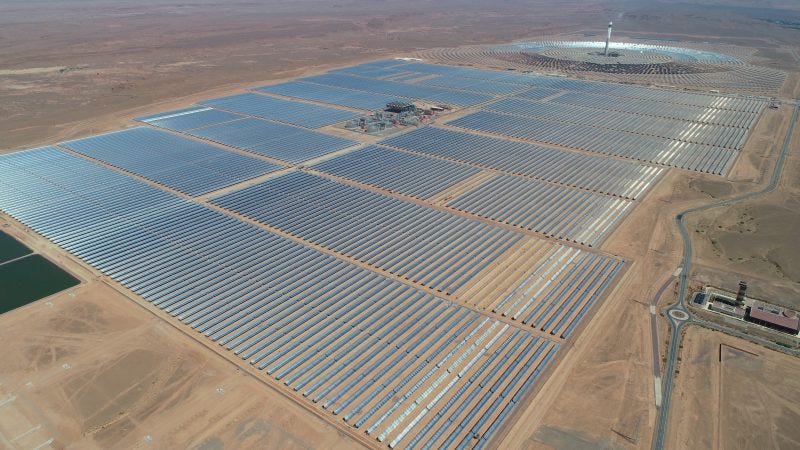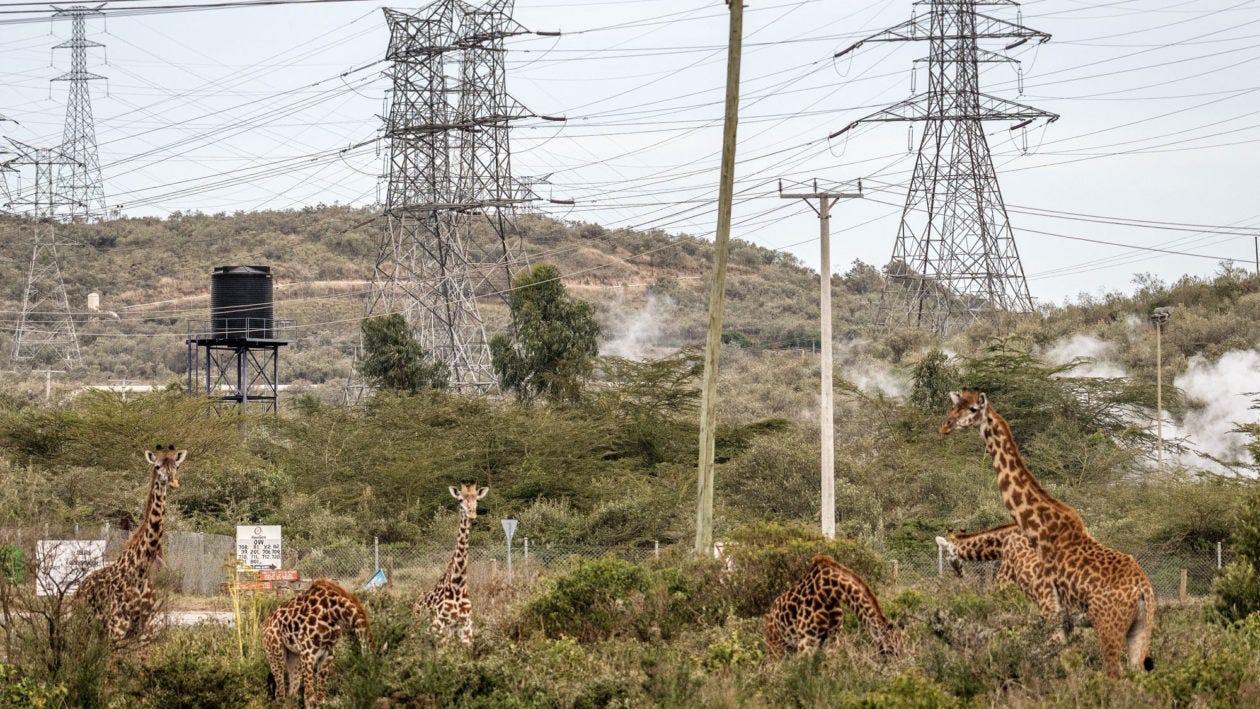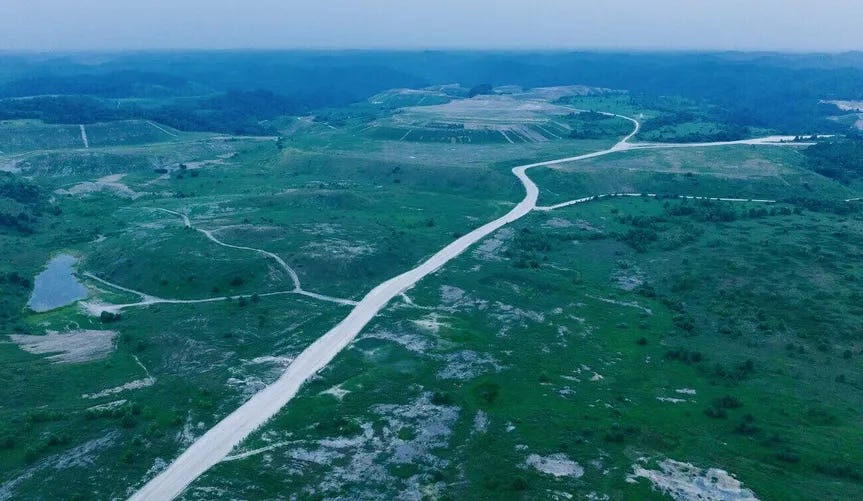The Weekly Anthropocene, August 16 2023
Progress on clean energy and public health across Africa, a big new solar farm to be built atop an old coal mine in Kentucky, AI tracks river dolphins in Brazil, and more!
Africa
Many Westerners’ stereotyped view of Africa is as a continent of catastrophe, now even more imperiled due to climate change. Recent news items seem to reinforce this, as the jihadism and desertification-plagued Sahel region slides closer to chaos after the recent military coup in Niger1. However, some African countries are making truly impressive progress in developing local manufacturing, clean energy, and public health capabilities.
Morocco is already relatively industrialized with a robust car-making industry and a growing inter-city high-speed rail network. Now, they’re investing heavily (along with Tunisia and Egypt) in building massive solar farms in the desert, with a view to selling extra power to Europe.
Morocco is also known for having the lion’s share of the world’s phosphate deposits. (At least, until the recent Norwegian discoveries). Scientists at Morocco’s Mohammed VI Polytechnic University are now spearheading a pioneering effort to create custom soil fertility maps across Africa. Their goal is to offer African farmers customized hyper-local fertilizer and land use recommendations. Increasing sub-Saharan Africa’s notoriously low agricultural productivity is one of the most important issues facing humanity (as Our World in Data ably explains), and this might be the start of important progress on that front!
Ghana is building a massive vaccine factory that should start production in 2025 and plans to create 600 million doses per year of various vaccines, including those for HPV, pneumonia, rotavirus, cholera, and (significantly) malaria. This could have amazing ripple effects for health across West Africa! Ghana is also working to develop a domestic lithium mining industry, as well as building solar farms (including some floating solar near a dam).
Nigeria is building West Africa’s first solar cell factory, and it may be on the verge of a boom in rooftop solar, as new President Bola Tinubu’s ending a highly expensive gasoline subsidy has undercut the economics of gas-powered generators. Nigeria’s grid is notoriously extremely fragile, with around 46% of Nigerians still having no access to electricity, and rooftop solar taking off would be a huge help.
Kenya is rapidly growing across a number of domains, with reliable Internet access and a burgeoning tech scene, peaceful and democratic 2022 elections, and impressive surges in access to electricity (from 32 of households in 2013 to 75% in 2022) thanks to a quickly expanding grid that’s already over 80% renewable, with strong geothermal and solar infrastructure. Many hope that Kenya could become an “anchor” for broader progress in East Africa, perhaps leading an African version of the famed “flying geese effect” in which Japan helped kickstart economic development across East Asia.
Rwanda is leading the world in drone delivery, having partnered with American startup Zipline to roll out a highly successful “national drone service” that has been transformative in rapidly delivering medicines, vaccines, blood (for transfusions), agricultural products, and more to isolated rural communities in the hilly country. Rwanda is also getting into mRNA vaccine manufacturing.
Africa is the last continent to begin full industrialization and electrification, and the first to have to do so against the headwind of climate change. But it’s also the first to be able to benefit so early in its development history from technologies like mRNA vaccines, cheap solar panels and delivery drones. One of the most important stories of the 21st century will be how and whether Africa will “leapfrog” developed-world mistakes, hopefully reaching a clean-energy powered prosperous future without having to go through decades of heavy fossil fuel use. That truly would be a good Anthropocene!
United States
The Starfire coal mine in Kentucky was once among the largest in the nation, leveling several Appalachian mountains into a series of plateaus. Now, developer BrightNight and EV startup Rivian have announced plans to build a giant 800-megawatt solar farm on 7,000 acres of former Starfire mining sites, starting construction in 2027 and finishing by 2030. This may end up as the largest solar farm in America east of the Mississippi…unless another project gets there first! It also has not-inconsiderable symbolic value, a new monument of the renewables revolution in the heart of coal country. That location also brings extra emissions benefits: Kentucky’s grid is one of the most carbon-intensive state electricity mixes left in the U.S., 71% coal-burning as of 2021, and lots of extra solar panel there will have outsize emission reduction effects. Great news!
From this writer’s home state of Maine, a few more local case studies from America’s clean energy revolution2.
The Maine state government will use several federal awards (including Bipartisan Infrastructure Law funding) to build more public electric vehicle charging stations across the state.
A boatyard in Islesboro recently demonstrated an electric boat, the Take Charge, powered by a 40 horsepower electric outboard motor. The Island Institute, a key voice for Maine’s waterfront communities, is working to advance electric boat technical courses and possible dockside charging points, with a view to advancing this new technology.
As expected, construction has restarted on the New England Clean Energy Connect transmission line project, which when complete will bring surplus electricity from Quebec hydropower dams to the New England grid, helping displace fossil fuels.
The Biden Administration announced over $450 million in funding to support rooftop solar and home battery installations in Puerto Rico, helping provide clean, decentralized, and resilient electricity to the hurricane-battered American commonwealth.
The White House is also working on a regulatory tweak to the National Environmental Policy Act (NEPA) with the goal of speeding up clean energy permitting (currently incredibly cumbersome, and easily hijack-able by anti-renewables opponents).
Four more offshore wind farms are being proposed off New Jersey, joining the three offshore wind projects already approved by the state.
Heatmap News reports that the Biden Administration is planning a world-first program to create a Department of Energy office to buy carbon removal services, with the goal of jumpstarting the American carbon removal industry, and providing an early customer for promising new technologies. This would be huge: as their article highlights, “Never before has any government paid to remove climate pollution from the atmosphere.” A formal announcement may come soon!
Brazil
Amazon river dolphins, or “botos,” are an endangered species that is notoriously hard to track and study, spending most of their time in hard-to-navigate Amazon Basin waterways and floodplains. Now, a team based out of Brazil’s renowned Mamirauá Institute of Sustainable Development is using AI and a network of underwater sound recorders to gain an unprecedented understanding of these fascinating creatures. The researchers trained an AI system to rapidly determine whether noises heard by the underwater “hydrophones” were dolphin clicks, boat engines, or just rain, eventually identifying dolphin sounds with 95% accuracy. This allowed them to learn about the dolphins’ movement patterns in response to seasonal floods, as well as automatically detect when boats were passing through core dolphin areas. Their study urges more use of such “passive acoustic monitoring” across Amazonia. Great work!
This newsletter tends to use stories from Maine as examples of local “on the ground” environmental progress in the U.S., both because Maine is an interesting microcosm of America in a variety of ways and because this writer really enjoys writing about Maine.









Exciting reading about such great, significant progress in Africa. The sad flipside of looking for an African country to be the "flying goose" for the rest of the continent is that this should totally have been South Africa, which is the most advanced, westernised country in Africa. Unfortunately, it looks like South Africa squandered it's chance and seems to be going in the other direction. I feel we're just waiting for Kenya, Nigeria, or someone else to eventually overtake them and truly lead.
What great, hopeful news! I love the piece about African developments and the possibility of that continent "leapfrogging" some of the errors of other developed areas. Learn from our mistakes!